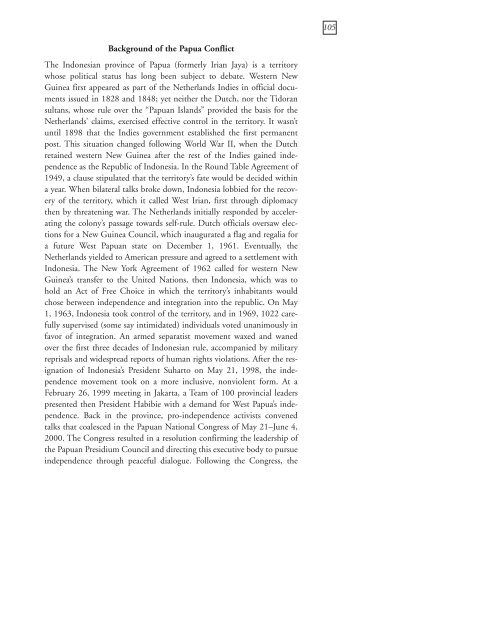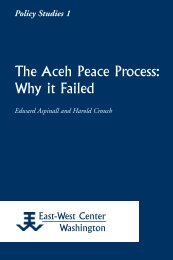Constructing Papuan Nationalism: History, Ethnicity ... - ScholarSpace
Constructing Papuan Nationalism: History, Ethnicity ... - ScholarSpace
Constructing Papuan Nationalism: History, Ethnicity ... - ScholarSpace
- No tags were found...
You also want an ePaper? Increase the reach of your titles
YUMPU automatically turns print PDFs into web optimized ePapers that Google loves.
105Background of the Papua ConflictThe Indonesian province of Papua (formerly Irian Jaya) is a territorywhose political status has long been subject to debate. Western NewGuinea first appeared as part of the Netherlands Indies in official documentsissued in 1828 and 1848; yet neither the Dutch, nor the Tidoransultans, whose rule over the “<strong>Papuan</strong> Islands” provided the basis for theNetherlands’ claims, exercised effective control in the territory. It wasn’tuntil 1898 that the Indies government established the first permanentpost. This situation changed following World War II, when the Dutchretained western New Guinea after the rest of the Indies gained independenceas the Republic of Indonesia. In the Round Table Agreement of1949, a clause stipulated that the territory’s fate would be decided withina year. When bilateral talks broke down, Indonesia lobbied for the recoveryof the territory, which it called West Irian, first through diplomacythen by threatening war. The Netherlands initially responded by acceleratingthe colony’s passage towards self-rule. Dutch officials oversaw electionsfor a New Guinea Council, which inaugurated a flag and regalia fora future West <strong>Papuan</strong> state on December 1, 1961. Eventually, theNetherlands yielded to American pressure and agreed to a settlement withIndonesia. The New York Agreement of 1962 called for western NewGuinea’s transfer to the United Nations, then Indonesia, which was tohold an Act of Free Choice in which the territory’s inhabitants wouldchose between independence and integration into the republic. On May1, 1963, Indonesia took control of the territory, and in 1969, 1022 carefullysupervised (some say intimidated) individuals voted unanimously infavor of integration. An armed separatist movement waxed and wanedover the first three decades of Indonesian rule, accompanied by militaryreprisals and widespread reports of human rights violations. After the resignationof Indonesia’s President Suharto on May 21, 1998, the independencemovement took on a more inclusive, nonviolent form. At aFebruary 26, 1999 meeting in Jakarta, a Team of 100 provincial leaderspresented then President Habibie with a demand for West Papua’s independence.Back in the province, pro-independence activists convenedtalks that coalesced in the <strong>Papuan</strong> National Congress of May 21–June 4,2000. The Congress resulted in a resolution confirming the leadership ofthe <strong>Papuan</strong> Presidium Council and directing this executive body to pursueindependence through peaceful dialogue. Following the Congress, the
















